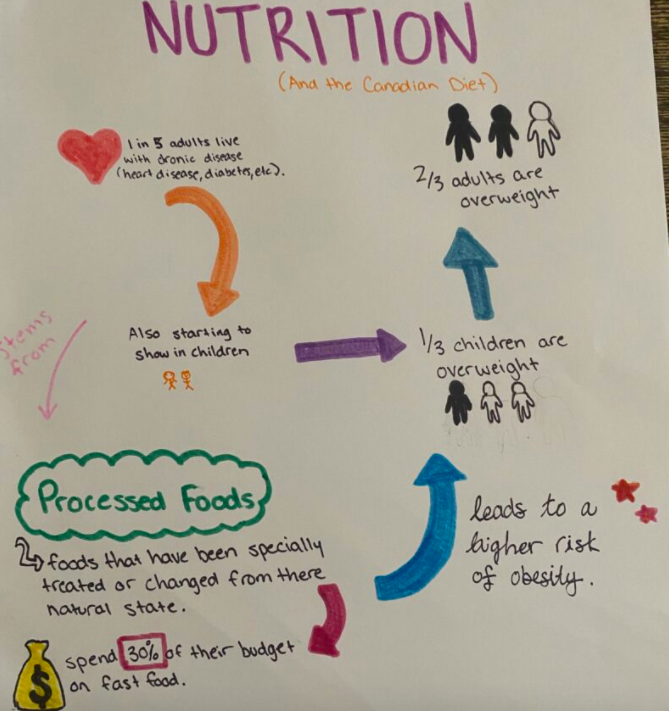The multimedia object that I decided to improve was my sketch note that I created back in week 6. I made a sketch note for my nutrition class to highlight some of the issues that are being seen with health and its correlation to the Canadian diet. The sketch note did a good job at incorporating written words with a visual text, which according to the study conducted by Fernades and colleagues (2018) students were able to retain more information for recall when visual images were associated with written text (as cited in McCue, 2018). However, after the last few weeks my knowledge surrounding multimedia has grown significantly, and although I think sketch notes is a great way to take notes, I think I can improve it by converting this sketch note into a screen cast. Below I have inserted my original sketch note.

I have found that my biggest struggle when listening to a lecture or studying is to be able to sift through information that is important, and extra information that is not relevant to the instructional goal. Therefore, when I was redesigning my multimedia, I decided that I wanted to focus on the five principles for reducing extraneous processing to ensure that my multimedia focuses on information that will be productive for studying.
According to Mayer and Fiorella (2014), there are five multimedia design methods that reduce extraneous overload; coherence, signalling, redundancy, spatial contiguity, and temporal contiguity principles. First, I looked at Coherence, which is the deletion of extra words, sounds or graphs. When looking at my sketch note I found that I had included too many arrows that lacked connection and made following the organization of information confusing. Thus, by using a screen cast I was able to explain how things were organized and how different ideas connected to one another. Next, I looked a signalling, which is highlighting essential words. I decided to highlight definitions and important concepts in bold and coloured text so that readers are able to distinguish them from other words on the page. Additionally, the redundancy principle states that students learn better when text on screen is short, so I made sure that when I did include text that it was concise. Furthermore, I looked at the spatial contiguity principle, which argues that pictures that are associated with words should be placed near words. Thus, when designing my screen cast I ensured that the pictures I used were next to words, and that the images I used were relative to the text I was using. Last, I looked at the temporal contiguity principle, which states that people learn better when narration and text, or images, are presented simultaneously. This principle is what made me decide to add narration to my sketch note. I thought the narration, as well as the addition of pictures to words, made it easier to understand how different ideas connected with one another.
References:
Mayer, R., & Fiorella, L. (2014). Principles for Reducing Extraneous Processing in Multimedia Learning: Coherence, Signaling, Redundancy, Spatial Contiguity, and Temporal Contiguity Principles. In R. Mayer (Ed.), The Cambridge Handbook of Multimedia Learning (Cambridge Handbooks in Psychology, pp. 279-315). Cambridge: Cambridge University Press.
McCue, R. (2022). Sketchnoting Workshop Introduction for EDCI 337 Lab. Youtube. Retrieved from https://www.youtube.com/watch?v=xxySeAj_GJs.
lukejr
2021-11-09 — 12:56 pm
Well done! You understood the assignment well. Stating how you changed and added to the artifact was clear and used many theories accordingly. Use of screencast was affective and allowed learner to follow your logic and make connections while offering visual and symbolic representations. Byy the end you also created an infographic which you could offer your learners as a supplemental take away from your session. (I learned a lot and need to look at my diet too!)